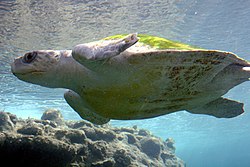| Nichollsemys Temporal range: Late Cretaceous | |
|---|---|
 | |
| Skull, Royal Tyrrell Museum in Alberta, Canada | |
| Scientific classification | |
| Domain: | Eukaryota |
| Kingdom: | Animalia |
| Phylum: | Chordata |
| Class: | Reptilia |
| Order: | Testudines |
| Suborder: | Cryptodira |
| Superfamily: | Chelonioidea |
| Genus: | † Nichollsemys Brinkman, 2006 [1] |
| Species | |
| |
Nichollsemys is a genus of extinct sea turtles. The only known species is Nichollsemys baieri. [2]




